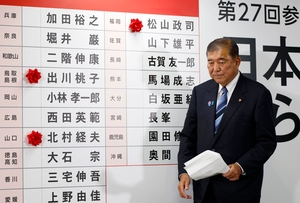Summary of Japan’s 2025 House of Councillors Election (~800 Words)
The 2025 election for Japan’s House of Councillors, held on July 20, marked a historic low point for Prime Minister Shigeru Ishiba and his ruling coalition of the Liberal Democratic Party (LDP) and Komeito. For the first time in the postwar era, the coalition has lost its majority in both chambers of Japan’s National Diet, underscoring mounting public frustration over economic stagnation, political scandal, and policy indecision.
Election Outcome and System
The House of Councillors—the upper chamber of Japan’s bicameral legislature—consists of 248 seats, with 124 seats subject to election every three years. Before the 2025 vote, the LDP-Komeito coalition controlled 75 of the 124 seats that were not up for re-election. To retain a majority, the coalition needed to win at least 50 of the contested 124 seats, reaching the 125-seat threshold for majority control.
However, preliminary results show the coalition fell short—capturing only 47 of the necessary 50 contested seats. One race remains undecided, but even a win there would leave the coalition at 123 seats, two shy of a majority. This loss compounds the political difficulties facing Prime Minister Ishiba, whose government has already operated in minority status since losing control of the Lower House during the October 2024 general election.
Governance Impact and Political Gridlock
The implications of this setback are significant. While the Upper House lacks the authority to unseat the prime minister directly, its loss poses a substantial challenge to the government’s ability to pass legislation. With both houses now under divided control, Ishiba will find it increasingly difficult to advance his policies without cooperating with the opposition—and that consensus may prove elusive given the current political climate.
This weakened mandate casts a shadow over the remaining tenure of Ishiba’s administration. Passage of key reforms—on tax policy, defense, immigration, and social welfare—will likely stall amid heightened partisan divisions. The opposition can now block or delay bills with greater ease, further diluting executive influence and potentially triggering early elections or internal party leadership changes.
Key Factors Driving the Coalition’s Defeat
Several interrelated domestic and international issues fueled voter dissatisfaction and contributed to the election loss:
– Economic Discontent: Persistent inflation, coupled with stagnant wages, has strained household finances. Aging demographics have driven up pension and medical costs, amplifying disaffection among working and retired voters alike.
– Scandal and Internal Division: The LDP has recently been rocked by a string of corruption scandals, including allegations of lawmakers accepting illicit gifts. Factional infighting and a perceived lack of leadership from Ishiba have further eroded the party’s public image.
– External Economic Pressure: Prime Minister Ishiba was also seen as faltering on trade issues. Months before the election, then-U.S. President Donald Trump reignited tariff threats targeting key Japanese industries, including the automotive and agricultural sectors. Critics accused the government of failing to shield national interests effectively.
– Voter Realignment: The public’s growing frustration with traditional parties led to a surge in support for alternative and populist voices. The centrist Democratic Party for the People (DPP) gained modest ground, while a significant number of votes swung to Sanseito, a right-wing, nationalist party that has capitalized on anti-establishment sentiment and anxiety over immigration and foreign influence.
– Policy Disconnect: Prime Minister Ishiba’s “Japan First” agenda—which included controversial proposals like gradually abolishing the consumption tax—failed to resonate with a weary electorate. Opposition parties, meanwhile, mobilized around more direct promises such as cost-of-living relief, public service expansion, and restrictive immigration controls.
Opposition Gains and Fragmentation
Despite the ruling coalition’s losses, the opposition remains deeply divided. The Constitutional Democratic Party of Japan (CDP), the DPP, the Japan Innovation Party, the Japanese Communist Party, and several smaller groups each increased their share of seats. Yet no single opposition bloc commands dominant influence or presents a unified alternative government. Mutual distrust and ideological differences—on issues ranging from taxation to foreign policy—have prevented the formation of a cohesive alliance.
One notable beneficiary of the political rupture is the nationalist Sanseito party. Despite gaining seats by promoting a hawkish stance on immigration and cultural preservation, its controversial views—including skepticism toward vaccines and conservative social values—limit its appeal to a broader electorate. Nonetheless, its rise reflects intensified polarization in Japanese politics and a growing appetite for change outside conventional party lines.
Leadership Pressure and Uncertainty
Prime Minister Ishiba initially expressed his determination to remain in office following the election results, citing the LDP’s continued role as the single largest party in the Diet. However, murmurs of discontent are growing within LDP ranks, with some party leaders openly questioning whether new leadership is needed to salvage their 2027 electoral prospects.
The opposition parties have so far ruled out formal alliances with the Ishiba government, making legislative progress difficult. Without a working majority and with no clear path to a grand coalition or bipartisan consensus, Japan risks entering a prolonged period of policy paralysis.
Political Landscape Going Forward
The 2025 House of Councillors election highlights growing volatility in Japan’s political environment. Structural challenges—such as an aging population, tepid economic growth, and geopolitical uncertainties—are fueling disillusionment with the traditional parties. Voters are increasingly gravitating toward issue-based and populist movements, fragmenting the political system and complicating governance.
Prime Minister Ishiba now faces the daunting challenge of sustaining a minority agenda in a legislature teeming with conflicting interests. Whether he can recover support, forge temporary alliances, or hold onto party leadership remains uncertain. In the absence of political stability, calls for another Lower House election—or a reshuffling of Japan’s political leadership—may intensify.
In sum, the 2025 Upper House election was less a single defeat than a loud signal of broader national unrest. Japan may now be entering a new era of coalition politics, uncertainty, and institutional recalibration.


